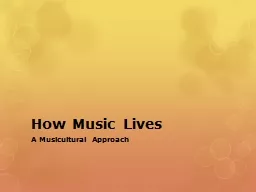

A Musicultural Approach Culture A classic definition Culture that complex whole which includes knowledge belief art law morals custom and any other capabilities and habits acquired by man humankind as a member of society ID: 491379
Download Presentation The PPT/PDF document "How Music Lives" is the property of its rightful owner. Permission is granted to download and print the materials on this web site for personal, non-commercial use only, and to display it on your personal computer provided you do not modify the materials and that you retain all copyright notices contained in the materials. By downloading content from our website, you accept the terms of this agreement.
Slide1
How Music Lives
A
Musicultural
Approach Slide2
Culture
A classic definition
Culture:
“that complex whole which includes knowledge, belief, art, law, morals, custom, and any other capabilities and habits acquired by man [humankind] as a member of society”
(Edward Tylor, 1871)
The guy who wrote itSlide3
Sound
Music
Culture
What it sounds like:A particular sequence of notes and rhythmsA Warao shaman’s song with a particular melodic direction (up or down)
A particular vocal quality of singing (e.g., Chinese opera--Listen: CD 1-5)
What it means:
The song “Mary Had a Little Lamb”
A song with power to cure vs. one with power to cause illness
An aesthetic of beauty to fans of Chinese opera, but maybe not to others Slide4
Identity
The Basics Questions:
Who am I?
Who are we?
Who is s/he? Who are they? Mongolian khoomii (CD 1-6)Rabbit Dance Song (CD 1-8 [start], CD 1-9 [cont.]) Eagle and Hawk (band) – “Dance” (CD 1-10)Slide5
Society
A group of persons regarded as forming a single community of related, interdependent individuals
Usually an “imagined community” (Anderson)
Defined by
social institutions—examples? Balinese sekehe gong (gamelan club) as a social institution (pp. 16-17)https://
www.youtube.com/watch?v=zPIZObNdJb0Listen: CD 2-12Slide6
Culture (again, but different)
Defining a specific culture, vs. defining “culture” as a broader concept
“A culture is defined mainly by a collective worldview shared by its members.” (p. 17)
Society = social institutions, social organization
Culture = ideas, beliefs, and practices that underscore social organizationRead: society vs. culture example re: Balinese gamelan
beleganjur (pp. 17-18)Listen: CD 2-14Slide7
Other Dimensions of Music/Identity
Nation and nation-state
Diaspora
Other types of transnational communities (worker communities,
virtual communities, etc.) The individual (multidimensional identities) Tito Puente (CD 4-7)—Cuban? Puerto Rican? New Yorker?Jazz, salsa, Latin jazz, “Cuban music”? Religion and spiritualityDance
Ritual (CD 1-12 Zaar—Egyptian/Sudanese healing ritual) Slide8
Music, Commodity, and Patronage
Who owns music and how?
Who has the write to sell it, buy it, disseminate it, trade it (commodification)?
Ex. Alan
Maralung “Ibis” (CD 1-13) Aboriginal Australian songmanDidgeridoo https://
www.youtube.com/watch?v=JEgXAu30yuY&list=RDGf0RrQ62jw8&index=7Who “owns” this performance?
Music patronage
Who supports musicians? Pays them? How and why? Slide9
Transmission, Creation Processes
Music transmission
— How music moves between individuals
and communities, locally and/or globallyDifferent models of production and reception of music: notation or not, formal teaching or not, specialized or not?Music creation processes
Composition—prior to performanceInterpretation
—making an existing composition “one’s own” (performers
and
listeners)
Improvisation
—in moment of performance
arranging
—transforming existing work Slide10
Music in the Process of Tradition
Tradition: “a process of creative transformation whose most remarkable feature is the continuity it nurtures and sustains
Paul Pena:
Genghis Blues
(film) and “Kargyraa Moan” (CD 1-18)